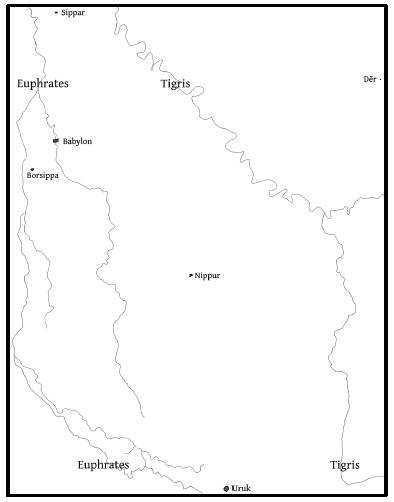Texts Excluded from RINBE 1/1
One of the texts attributed to Nabopolassar in Da Riva, SANER 3 is excluded from the present volume. After closer examination of the C011 inscription,[[98]] a small clay cylinder fragment with parts of ten lines of text discovered at Larsa (mod. Tell as-Senkereh), it is now certain that that piece is inscribed with a duplicate of Nebuchadnezzar II inscription C24, a text recording the renovation of the Ebabbar ("Shining House") temple of the sun-god Šamaš at Larsa. Since fragment L 74.7 bears an inscription of Nebuchadnezzar from Larsa, that piece will be edited together with the C24 inscription in RINBE 1/2. Moreover, with regard to texts of/concerning Nabopolassar, following the editorial practices of RINBE (as well as RIMB and RINAP), historical-literary compositions and (fictional) royal correspondence are excluded from the present volume. Thus, one will not find editions (or translations) of the "Nabopolassar Epic,"[[99]] "Declaring War," and "Letter of Sîn-šarra-iškun" texts.[[100]]
As already mentioned, in the section Texts Included in RINBE 1/1, approximately half of the Nebuchadnezzar II corpus is excluded from the present volume. Therefore, RINBE 1/2 will include: (1) inscriptions written or stamped on glazed and baked bricks from Babylon, including the Ištar Gate Inscription; (2) inscriptions from other Babylonian cities, namely Borsippa (mod. Birs Nimrud), Kish (mod. Tell Uhaimir), Larsa (mod. Tell as-Senkereh), Marad (mod. Wanna-wa-Sadum), Sippar (mod. Tell Abu Habbah), Ur (mod. Tell Muqayyar), and Uruk (mod. Warka); (3) texts engraved on beads, eyestones, and weights from Babylonia and Persepolis (the capital of the Persian Empire); and (4) rock reliefs from the Levant, namely the Nahr el-Kalb and Wadi Brisa inscriptions. Note, however, that provisional editions of all of those texts are currently accessible via the "Babylon 7" subproject of the open-access, Oracc-based RIBo Project.[[101]]
In addition, several small fragments of cylinder inscriptions that are too small or too badly preserved for a secured identification, and these texts, even if they are assumed to belong to Nebuchadnezzar II, will also be included with the Nebuchadnezzar 1000-numbers, even if they were found at Babylon.

Figure 3. Map of Babylonia, including Babylon and Sippar, the two sites where the inscriptions of Nabopolassar and Nebuchadnezzar II edited in the present volume were found.
98 Da Riva, SANER 3 pp. 104–105 §2.2.8 C011.
99 Da Riva, JNES 76 (2017) p. 82 ii 10´–16´. See Gerber, ZA 88 (1998) p. 83; and Tadmor, Studies Borger pp. 353–357.
100 See n. 16 for details.
101 See http://oracc.org/ribo/babylon7/pager [last accessed 14 February, 2024].
Jamie Novotny & Frauke Weiershäuser
Jamie Novotny & Frauke Weiershäuser, ' Texts Excluded from RINBE 1/1', RIBo, Babylon 7: The Inscriptions of the Neo-Babylonian Dynasty, The RIBo Project, a sub-project of MOCCI, 2024 [/ribo/babylon7/RINBE11Introduction/TextsExcludedfromRINBE11/]